 W
WThe Achievement Medal is a military decoration of the United States Armed Forces. The Achievement Medal was first proposed as a means to recognize the contributions of junior officers and enlisted personnel who were not eligible to receive the higher Commendation Medal or the Meritorious Service Medal.
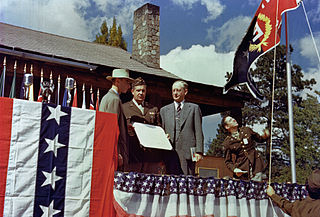 W
WThe Army-Navy "E" Award was an honor presented to companies during World War II whose production facilities achieved "Excellence in Production" ("E") of war equipment. The award was also known as the Army-Navy Production Award. The award was created to encourage industrial mobilization and production of war time materials. By war's end, the award had been earned by only 5% of the more than 85,000 companies involved in producing materials for the U.S. military's war effort.
 W
WBadges of the United States Army are military decorations issued by the United States Department of the Army to soldiers who achieve a variety of qualifications and accomplishments while serving on active and reserve duty in the United States Army.
 W
WThe Brigadier General David H. Stem Award is a unit trophy annually awarded by the United States Army to a Military Police unit.
 W
WThe Brigadier General Thomas F. Barr Award is a unit trophy annually awarded by the United States Army to a military police unit working with the United States Army Corrections Command. It was first awarded in 2009.
The Bronze Star Medal is a United States decoration awarded to members of the United States Armed Forces for either heroic achievement, heroic service, meritorious achievement, or meritorious service in a combat zone.
 W
WThe Butler Medal, also known as the Colored Troops Medal, was a military decoration of a unit of the United States Army which were issued in 1865. The medal was commissioned by Major General Benjamin Butler and was intended to recognize meritorious or heroic acts of bravery performed by African American soldiers at the Battle of Chaffin's Farm and New Market Heights. Fourteen African Americans had earned the Medal of Honor in that engagement, but Butler wished to further recognize his African American troops involved in the battle, and he paid for the Butler Medals out of his personal funds.
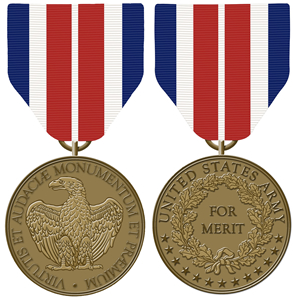 W
WThe Certificate of Merit Medal was a military decoration of the United States Army that was issued between the years of 1905 and 1918. The Certificate of Merit Medal replaced the much older Certificate of Merit which was authorized by the United States Congress on March 3, 1847.
 W
WThe Combat Infantryman Badge (CIB) is a United States Army military decoration. The badge is awarded to infantrymen and Special Forces soldiers in the rank of colonel and below, who fought in active ground combat while assigned as members of either an Infantry or Special Forces unit of brigade size or smaller at any time after 6 December 1941. For those soldiers who are not members of an infantry, or Special Forces unit, Combat Action Badge (CAB) is awarded instead. For soldiers with an MOS in the medical field with the exception of a Special Forces Medical Sergeant (18D), the Combat Medical Badge is awarded to them.
 W
WThe Distinguished Service Cross is the United States Army's second highest military award for extreme gallantry and risk of life in actual combat with an armed enemy force. Actions that merit the Distinguished Service Cross must be of such a high degree that they are above those required for all other U.S. combat decorations, but which do not meet the criteria for the Medal of Honor. The Distinguished Service Cross is equivalent to the Navy and Marine Corps' Navy Cross, the Air Force and Space Force's Air Force Cross, and the Coast Guard Cross.
 W
WThe Distinguished Service Medal (DSM) is a military award of the United States Army that is presented to any person who, while serving in any capacity with the United States military, has distinguished himself or herself by exceptionally meritorious service to the Government in a duty of great responsibility. The performance must be such as to merit recognition for service that is clearly exceptional. Exceptional performance of normal duty will not alone justify an award of this decoration.
 W
WExcellence in Armor (EIA) is a program of the United States Army Training and Doctrine Command that awards outstanding Armor and Cavalry Soldiers whose performance is routinely above the standard and demonstrate superior leadership potential. The EIA was initially proposed in May 1984 and implemented in October 1987. The program rewards outstanding armor and cavalry soldiers with a Certificate of Achievement, a challenge coin from the U.S. Army's Chief of Armor, awarding of the personnel development skill identifier (PDSI) “E4J,” and will set the soldier apart from their peers during promotion boards.
 W
WThe Expert Soldier Badge, or ESB, is a special skills badge of the United States Army. Similar in appearance to the Combat Action Badge, the ESB would be awarded to soldiers who are neither infantry, Special Forces, nor combat medics. The badge was approved on June 14, 2019 and entered service in October 2019, as a way for soldiers in other military occupational specialties to certify competencies within their specific occupation, as well as general combat readiness.
 W
WThe Gillmore Medal is a military decoration of the United States Army which was first issued on October 28, 1863. The medal is named after Maj. Gen. Quincy A. Gillmore who commanded Union troops attempting to seize Fort Wagner in 1863 during the American Civil War.
 W
WThe Good Conduct Medal is one of the oldest military awards of the United States Armed Forces. The U.S. Navy's variant of the Good Conduct Medal was established in 1869, the Marine Corps version in 1896, the Coast Guard version in 1923, the Army version in 1941, and the Air Force version in 1963; the Air Force Good Conduct Medal was temporarily discontinued from February 2006 to February 2009, followed by its subsequent reinstatement.
 W
WThe infantry blue cord is a United States military decoration worn over the right shoulder of all infantry-qualified U.S. Army soldiers. It is a fourragere in light blue, specifically PMS 5415, worn under the right shoulder and under the right epaulette of a U.S. Army infantry soldier's Class A dress blue uniform jacket or Class B shirt. The cord is composed of a series of alternating left and right half knots that are tied around a leader cord to form a "Solomon bar".
 W
WThe United States Army's Master Gunner Identification Badge (MGIB) recognizes soldiers who complete one of eight U.S. Army master gunner courses and is an indicator for commanders and soldiers to value the master gunner's advice regarding the training and employment of weapon systems.
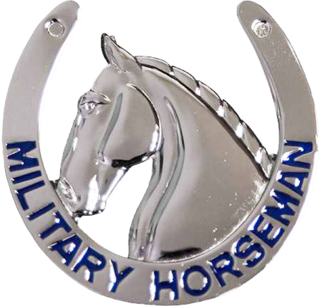 W
WThe Military Horseman Identification Badge recognizes United States Army soldiers who complete the nine-week Basic Horsemanship Course and serve as a lead rider on the Caisson team within the 3rd U.S. Infantry Regiment. The badge was first awarded on September 29, 2017, to soldiers during a ceremony held at Joint Base Myer-Henderson Hall, Virginia.
 W
WThe Noble Patron of Armor award is the top award given to supporters of the Army's mounted force by the United States Armor Association of the United States Army.
 W
WThe Order of Military Medical Merit (02M3) is a private organization that was founded by the Commanding General of the U.S. Army Health Services Command in 1982 with the goal of recognizing excellence and promoting fellowship and esprit de corps among Army Medical Department (AMEDD) personnel. Medical personnel from all branches of the United States military are eligible for the award. Membership in the Order denotes distinguished service which is recognized by the senior leadership of the AMEDD, and is signified with the presentation of a white brass or sterling silver medallion on a maroon ribbon.
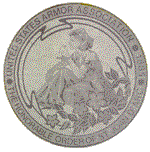 W
WThe Order of St. Joan D'Arc Medallion is the top volunteerism award given by the United States Armor Association of the United States Army.
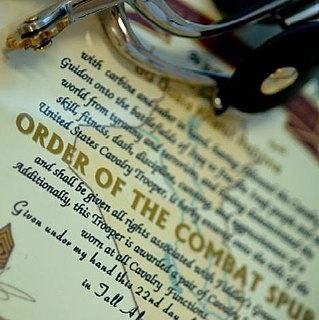 W
WThe Order of the Spur is a Cavalry tradition within the United States Army. Soldiers serving with Cavalry units are inducted into the Order of the Spur after successfully completing a "Spur Ride" or for having served during combat as a member of or with a Cavalry unit. A trooper who has earned both Silver and Gold spurs is known as a "Master Spur Holder." Traditionally, each Trooper is presented spurs by his sponsor at a ceremonial dining in commonly referred to as the "Spur Dinner". The spurs are to be worn with the military uniform during Squadron or Regimental ceremonies and events or as designated by the Cavalry unit commander. In some units, gold spurs are awarded for combat inductions while silver spurs represent having completed the Spur Ride. Within the tradition, silver spurs and gold spurs hold a similar relationship for the cavalry as the Expert Infantryman Badge hold in the U.S. Army Infantry, as well as the Expert Field Medical Badge and the Combat Medical Badge hold to U.S. Army Medics. There is no Military Occupational Specialty (MOS) requirement for the Order of the Spur and the order is open to members of foreign militaries serving with U.S. Cavalry units.
 W
WAn Overseas Service Bar is an insignia worn by United States Army soldiers on the Army Service Uniform, and previously on the Army Green and the Army Blue uniforms, that indicates the recipient has served six months overseas in a theater of war.
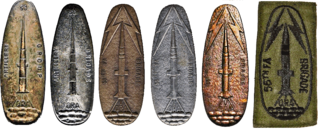 W
WThe Pershing Professionals Badge is a local individual award created by the 56th Artillery Group to recognize proficiency on the nuclear Pershing missile system. It was awarded from December 1968 through 1979.
 W
WA Reserve Good Conduct Medal refers to any one of the five military conduct awards, four of which are currently issued and one of which was previously issued, by the United States Armed Forces to enlisted members of the Reserve and National Guard. The primary difference between the regular Good Conduct Medal and the Reserve Good Conduct Medal is that the regular Good Conduct Medal is only issued for active duty service while the reserve equivalent is bestowed for reserve duties such as drills, annual training, and additional active duty for either training or operational support to the active duty force or, in the case of the Army National Guard and Air National Guard, in support of Title 32 U.S.C. state active duty (SAD) such as disaster response and relief.
 W
WThe ROTC Medal for Heroism is the highest United States Department of the Army medal awarded exclusively to Army Reserve Officers' Training Corps cadets. This award is presented to cadets who perform acts of heroism. As with other Department of the Army decorations, the award consists of a medal and ribbon, accompanied by DA Form 638. In the Army, this award is also known as the Medal of Heroism.
 W
WThe Order of Saint George Medallion is the top award given to members of the Army's mounted force by the United States Armor Association of the United States Army. The award is issued as a black, bronze, silver, or gold medallion, depending on the recipient's eligibility. As of June 2017, a total of 76 Gold OSGs and 4 Gold NPAs had been awarded, and a total of just over 10,000 medallions of all types.
 W
WThe Soldier's Medal is an individual decoration of the United States Army. It was introduced as Section 11 of the Air Corps Act, passed by the Congress of the United States on July 2, 1926. The criteria for the medal are: "The Soldier's Medal is awarded to any person of the Armed Forces of the United States or of a friendly foreign nation who, while serving in any capacity with the Army of the United States, including Reserve Component soldiers not serving in a duty status at the time of the heroic act, distinguished himself or herself by heroism not involving conflict with an enemy."
 W
WThe Superior Cadet Decoration Award is the second highest Department of the Army medal awarded exclusively to Reserve Officers' Training Corps cadets. This award is presented annually to the outstanding cadet in each year of Military Science at each of the respective ROTC units. As with other Department of the Army decorations, the award consists of a medal, ribbon, and lapel button with case, accompanied by DA Form 1773 signed by the regimental commander on behalf of the Secretary of the Army. In the Army, this award is also known as the Superior Cadet Decoration and the Superior Cadet Medal.
 W
WThe Superior Unit Award is a decoration of the United States Army which is awarded in peacetime to any unit of the Army which displays outstanding meritorious performance of a difficult and challenging mission carried out under extraordinary circumstances.
 W
WIn the United States Army, "tabs" are small cloth and/or metal arches displaying a word or words signifying a special skill that are worn on U.S. Army uniforms. On the Army Combat Uniform, the tabs are worn above a unit's shoulder patch and are used to identify a unit's or a soldier's special skill(s) or are worn on shoulder patches as part of a unit's unique heritage. Individual tabs are also worn as small metal arches above or below medals or ribbons on the Army Service Uniform.
 W
WThe Women’s Army Corps Service Medal was a military award of the United States Army which was created on July 29, 1943 by Executive Order 9365 issued by President Franklin Roosevelt. The medal was intended to recognize the service of women to the Army during the Second World War. The profile featured on the medal is that of the goddess Pallas Athena; the same profile was used for the Women's Army Corps branch insignia.